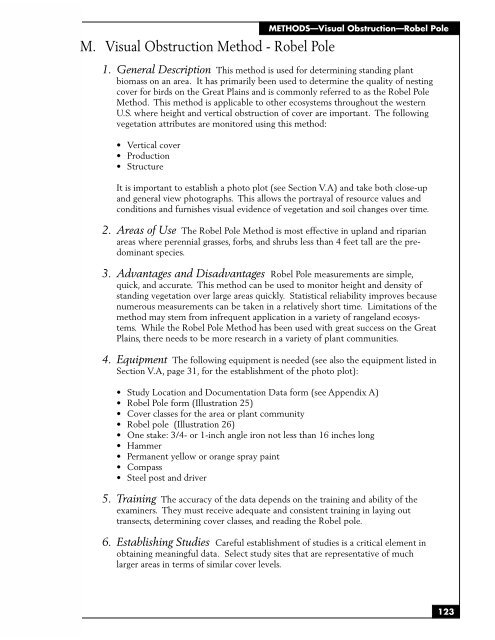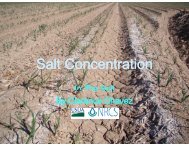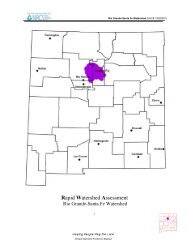SAMPLING VEGETATION ATTRIBUTES - New Mexico NRCS - US ...
SAMPLING VEGETATION ATTRIBUTES - New Mexico NRCS - US ...
SAMPLING VEGETATION ATTRIBUTES - New Mexico NRCS - US ...
You also want an ePaper? Increase the reach of your titles
YUMPU automatically turns print PDFs into web optimized ePapers that Google loves.
M. Visual Obstruction Method - Robel Pole<br />
METHODS—Visual Obstruction—Robel Pole<br />
1. General Description This method is used for determining standing plant<br />
biomass on an area. It has primarily been used to determine the quality of nesting<br />
cover for birds on the Great Plains and is commonly referred to as the Robel Pole<br />
Method. This method is applicable to other ecosystems throughout the western<br />
U.S. where height and vertical obstruction of cover are important. The following<br />
vegetation attributes are monitored using this method:<br />
• Vertical cover<br />
• Production<br />
• Structure<br />
It is important to establish a photo plot (see Section V.A) and take both close-up<br />
and general view photographs. This allows the portrayal of resource values and<br />
conditions and furnishes visual evidence of vegetation and soil changes over time.<br />
2. Areas of Use The Robel Pole Method is most effective in upland and riparian<br />
areas where perennial grasses, forbs, and shrubs less than 4 feet tall are the predominant<br />
species.<br />
3. Advantages and Disadvantages Robel Pole measurements are simple,<br />
quick, and accurate. This method can be used to monitor height and density of<br />
standing vegetation over large areas quickly. Statistical reliability improves because<br />
numerous measurements can be taken in a relatively short time. Limitations of the<br />
method may stem from infrequent application in a variety of rangeland ecosystems.<br />
While the Robel Pole Method has been used with great success on the Great<br />
Plains, there needs to be more research in a variety of plant communities.<br />
4. Equipment The following equipment is needed (see also the equipment listed in<br />
Section V.A, page 31, for the establishment of the photo plot):<br />
• Study Location and Documentation Data form (see Appendix A)<br />
• Robel Pole form (Illustration 25)<br />
• Cover classes for the area or plant community<br />
• Robel pole (Illustration 26)<br />
• One stake: 3/4- or 1-inch angle iron not less than 16 inches long<br />
• Hammer<br />
• Permanent yellow or orange spray paint<br />
• Compass<br />
• Steel post and driver<br />
5. Training The accuracy of the data depends on the training and ability of the<br />
examiners. They must receive adequate and consistent training in laying out<br />
transects, determining cover classes, and reading the Robel pole.<br />
6. Establishing Studies Careful establishment of studies is a critical element in<br />
obtaining meaningful data. Select study sites that are representative of much<br />
larger areas in terms of similar cover levels.<br />
123




